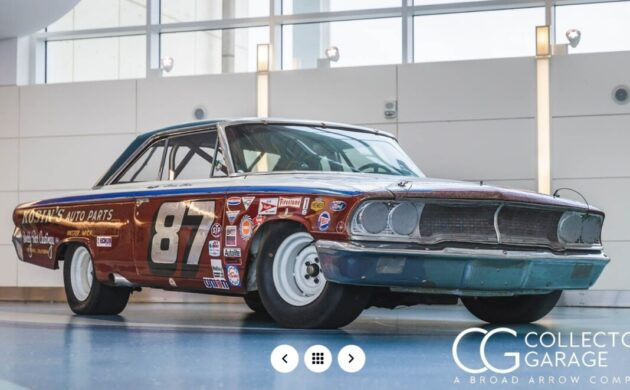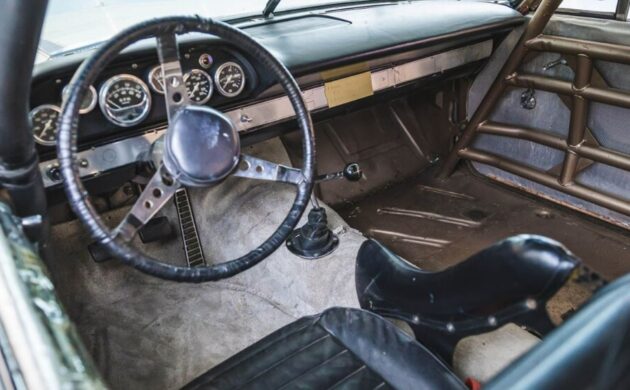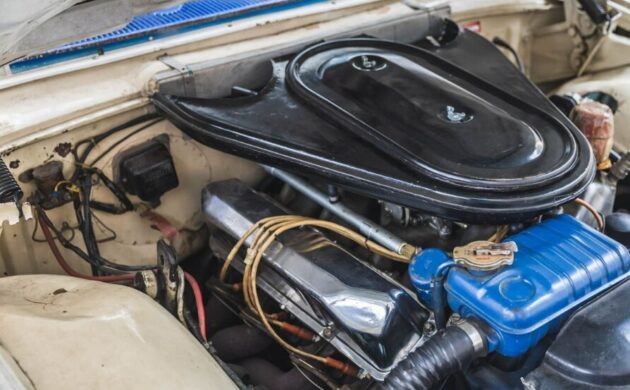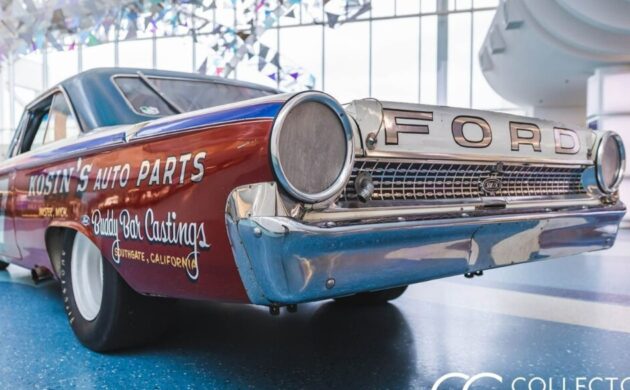The partnership between Ford Motor Company and Dearborn Steel Tubing Company (DST) produced show cars and race cars built by DST, which acted as a specialty manufacturing house for Ford. When DST’s Jim “Hammer” Mason decided to go racing, Ford dusted off an early prototype that had never raced for Mason. Now you can own this racing Galaxie as it comes up for sale here on CollectorsGarage, where $125,000 seals the deal. Even if you’re not a buyer on this go-fast-turn-left Ford, check out more than 150 gorgeous pictures and some stories about this unique racer’s history. If you haven’t heard of “Hammer” Mason, it might pique your interest to know that Curtis Turner and Bobby Allison sawed through some corners behind the wheel. Our thanks to reader Kyle K. for spotting this well-preserved slice of racing history.
That goose-neck shifter design would clear the bench seat in a six-seater Galaxie, but there’s only room for one in this high-performance Ford. Vinyl tape on the steering wheel adds some friction. While at least two poseur-mobiles within a mile of you in traffic probably have bright tape at 12 o’clock to boost their faux street cred, note the lack of such accouterments in this real racer.
A dual quad 427 cid (7.0L) V8 provides the thrust, and the street version made “425” HP, which seemed to be the top number Detroit would list on paper in those days. That may be conservative if you believe dynamometer ratings, and racing versions certainly made more. What might be mistaken as a stock performance induction housing came from Ford’s engineer Donnell “Pop” Sullivan, a resource available to DST’s Mason. Cowl induction takes advantage of a naturally occurring low pressure zone at the base of the windshield, and its advantage is more than theoretical. Cars with this air filter housing gained 3½ mph at Daytona International Speedway, according to the seller.
The “1963 1/2” Galaxie refers to the more steeply raked rear roofline that made the mid-year body style more slippery at the track. Because of its internal use by Ford, this one hit the track in 1966, winning the Daytona-Permatex 300 that year with Turner at the wheel, according to the listing.
Examining a racing car in detail often reveals DIY engineering, and the stacks of shim tell a story of needing more alignment adjustment for a Sunday drive at Daytona than the average owner needed for their trip to church. You could probably spend all day discovering modifications to what was truly a “stock car” in those days before NASCAR became a spec race. If you had Jay Leno money, would you keep this racer in museum condition or let it loose on the track?







Lovely Ford.
Better get ready for Godwood Revival!
Great piece of Ford racing history.
Awesome car! 60’s really were the best years for NASCAR. cars were identifiable without the fake headlight decals and cookie-cutter bodies. Loved the full sized racers from all the divisions within the big 3.
How about the 1-2 shift in this rocket 🚀
This is an awesome site
Exactly Stan, exactly.
I have been in a 427, Ford center oiler single 4 barrel, solid lifter cam – unreal.
My brother’s ’69 Mustang Mach 1: restored like new that originally had a 428 cj and this 427 was put in its place, circa 1986, bought from Jacky Jones Ford for $8,000. Unreal.
This 427 even in street version at 425 hp with the R code 2 x 4 barrel Holley, solid lifter would be a beautiful thing.
Would pay $$ for a ride.
GLWTS!!!
Now that some workers are returning to the office, this would make the perfect vehicle for someone’s renewed commute to work…
“Hey Jim, gotta climb in through the window” “what?” “GOTTA CLIMB IN THROUGH THE WINDOW” “WHAT?” “oh never mind”
How could you not race it if it were yours?
The 63(and 1/2s) and ’64s were my favorite stock cars. I built more plastic models of those cars than any other, and at 8 and 9 years old, I knew what I was doing,,,anyway, most of my heroes drove these cars. Some big,,,no, HUGE names drove these, Marvin Panch, Tiny Lund, Fred Lorenzen, Dan Gurney, AJ Foyt, and many more. Ironically, “Fireball Roberts” died as a result of being engulfed in a fireball in one. There’s a video with Joey Logano driving a vintage ’63 Ford stock car, and he looked petrified. He said he just didn’t feel safe, and rightly. This was nothing more than a glorified sedan, not much different from the showroom models( Dick Trickle had a cigarette light in his car) and can’t compare to todays modern racers. It was a slow process, with crew chiefs experimenting with handling with what they had, a washer here, a camber adjustment there, but still had freakin’ vent windows. THIS,,,my friends, was racing and Ford was the best, but was short lived, as in ’66, the Chevy 427 evened the score.
Very cool find, now, I’ll simply zoom over to Ebay for a vintage plastic model kit to really relive memories, heck, they were $1.99 back then, paint was a quarter a bottle($ 0.59 for that fancy spray can), how much could it possibly have gone up? A HUNDRED BUCKS!!! PAINT $20 BUCKS!! You know, I broke my antenna mast on my Jeep thanks to a early wet spring snow, a replacement, if I could find on( 31″) just the mast, mind you( with several “universal” screws),,,$22.35,,,I know, but really, for a freakin’ piece of wire? You simply can’t win today and I admire those that still try.
Here you go, and it is very streetable And a lot cheaper .
This is the car the 427 engine is in
Absolutely incredible car and history… For those with a half hour or so to spare, here’s a link to footage from the 1967 Permatex 300 at Daytona that shows the car racing with Curtis Turner at the wheel… here’s the link!
https://youtu.be/MaIEpLAKQ4U
When my friends and I were in high school and all our dads worked for car companies, and would bring home “company cars”, we didn’t realize how remarkable all that would seem decades later. My dad worked for GM Research in this era, and later, Marketing staff, where his group was responsible for analysis stuff, things like tracking market share, forecasting what colors and body styles were going to be popular, conducting surveys and such.
Close friends’ dads were, respectively, head of Chrysler, a VP at Ford, and son of the head of engineering for Ford’s transmission and axle division. That all added up to rides in an automatic 289 Cobra, and, as the Muscle Car era was dying, a blue Vega with an aluminum small block left over from the Jim Hall Chaparral program that was nicknamed “The Crunch Bird”, named after a short animated film that won an academy award in 1971, featuring a cartoon bird of the same color as the Vega. That car appeared in Hot Rod shortly after, but adorned with stripes.
The Ford powertrain engineering group would use whatever they had available to stress test axles and transmissions. I got a terrifying ride one Saturday afternoon on a 2-lane road with my friend’s dad at the wheel of a 4-door sedan with a motor like this one, with a 4-speed and a 4.56 rear axle.
Fantastic story! You were a lucky kid.
With only one seat…you could go get a lot of groceries….
I saw this car in the Jacksonville International Airport in March. I snapped some photos of it there. I caught myself fantasizing about firing it up and blasting down one of the runways!
Looking at the gauge cluster reminded me of something I noticed years ago while I was at the Talladega Museum. I had the entire museum to myself on a rainy weekday afternoon. I slid into one of Fireball Roberts old cars and noticed that all of the gauges were mounted cock-eyed. I looked into several other old cars and noticed the same thing. I mentioned it to one of the employees and he told me they did that so when they were racing they could simply glance down and if everything was OK, the needles on the gauges would be pointed straight up but if something was awry the needle would be pointed off to one side or the other.